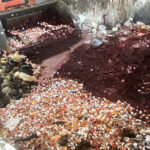The Essex Junction, Vermont, Water Resource Recovery Facility is “pretty darn close” to achieving net zero energy use with a 150 kW CHP unit, energy efficiency upgrades and a 150 kW solar array.
Marsha W. Johnston
BioCycle September 2015
Soon to be fully tuned and ready for full operation, the Village of Essex Junction, Vermont’s Water Resource Recovery Facility’s (WRRF) will be closer to its goal of achieving net zero energy use. With a new 150-kW combined heat and power (CHP) system, a new 150-kW solar array, geothermal well, solar heating wall and the other elements of its $15.3-million, four-year maintenance upgrade, “we will be pretty darned close,” says James L. Jutras, Water Quality Superintendent for the Village of Essex Junction. Achieving net zero requires continued optimization of the various pieces of its energy puzzle.
The Essex Junction WRRF began primary wastewater treatment in 1965, and was upgraded to then-state of the art in 1985. “The original plant and the improved plant had an anaerobic digester and the methane was used to fire the boiler, so we have had a culture of digestion and bioenergy since the beginning,” explains Jutras. Nonetheless, he adds, long-term electricity rate stability and energy conservation, not net zero electricity, were its primary objectives. “You could say that net zero electricity found us,” he says. Indeed, it wasn’t until 2003 that Essex Junction installed two 30-kW Capstone microturbines to use 100 percent of its biogas to generate electricity onsite to power pumps and other treatment process equipment.
But the aging facility still suffered from a lack of equipment and backup in certain areas that were required by operating permits, such as effluent filters, clarifiers and electrical systems. “In the 1980s, when the effluent filter was built, we required only one, but now we needed two,” Jutras explains. “We had two secondary clarifiers [settling tanks], but the design standard now requires three, so we had to build another, and the anaerobic digester’s whole electrical system had to be upgraded to be explosion proof.”
Earlier Essex Junction WRRF upgrades had been implemented with state and federal grant funds that were no longer available or at only much-reduced levels. Therefore, in 2011, the WRRF asked voters in Essex Junction to approve the expenditure of $15.3 million to rehabilitate its existing equipment while adding new replacement treatment processes. The voters agreed that they wanted a WRRF designed for long-term service to the community that would also protect the water quality of their iconic, nearby Lake Champlain.
Working with local water resource engineering firm Aldrich + Elliott, Jutras and his staff evaluated existing infrastructure to be certain they took as much advantage of the existing facility as possible, recycling and repurposing buildings and constructing only when necessary to add value to the process. “Aldrich + Elliott proved a perfect partner for this exercise,” says Jutras. For example, the firm determined that it was more economical to demolish the old effluent filter, repurpose its containment building for bulk chemical storage, and build a new building for the three filters now required.
After two years of construction, the Essex Junction WRRF is a 3.3 million gallons/day (MGD) facility (with a current flow rate of 2.0 MGD) with advanced treatment and removal of nutrients. Pollutants such as phosphorus are removed down to 0.2 mg/L, which is the most recent effluent phosphorus standard for wastewater treatment facilities. “The discharge limits went from 0.8 mg/L to 0.2 mg/L,” Jutras notes. “We are meeting the 0.2 standard now, with our current flows. We currently use biological phosphorus removal accompanied by ferrous chloride and sodium aluminate for chemical phosphorus removal [and] will likely connect additional feed points for more efficient and effective feed of these chemicals to supplement the biological processes. If we had to filter down further, to say 5 microns, we would have to build a new section, but the new filter building is designed to accommodate additions.”
Codigestion Feedstocks
Essex Junction receives 10,000 to 16,000 gallons/month of FOG (fats, oils and grease), primarily consisting of trap grease from restaurants and local beauty products manufacturer Autumn Harp. This is about a third of the commercial volume (8,000-12,000 gallons/week) that the plant had been taking. “Material that came from a food manufacturer arrived hot and laden with fats,” Jutras explains. “It did not stay in solution in the digester and created operational issues due to its sheer volume. It is now going to a farm digester in Green Mountain Power’s Cow Power program.”
Essex Junction also accepts Keurig/Green Mountain Coffee Roasters’ new waste stream, a syrupy product that results from its new cold beverage line. “Fed in a controlled manner, it has had a great impact on volatile solids reduction in our digestion process,” he says, adding that the simple syrup has boosted biogas production 20 to 25 percent at a limited volume over the past few years with no negative impact on the digester.
A custom-engineered feedstock management system connected to the digester’s influent flow control meter monitors the daily feed total. A new SCADA control system automatically feeds the high-strength wastes into the digester at a rate based on available hydraulic capacity. “The whole idea is to feed a little daily and automatically with the least amount of operator intervention,” Jutras says. The system is comprised of three plastic tanks recycled from other treatment plant operations (two sized at 3,000 gallons and one at 6,000 gallons) to accept liquid waste deliveries from beverage manufacturers; a small peristaltic centrifugal feed pump; a variable frequency pump control drive; and a pipe connection to the digester.
On the energy conservation side of the WRRF’s upgrades, an adaptive aeration control system has further maximized the plant’s membrane aeration efficiency, which was installed in 2000, by allowing a greater flexibility in applying air with one of the plant’s three blowers/compressors (75 HP, 100 HP and 125 HP). “The state standards like us to use big blowers for redundancy, but this allows us to use a smaller and a larger one to meet the highest demand need, with less capital and more energy savings,” Jutras explains.
Repurposing its existing infrastructure enabled Essex Junction to save more energy in its return-activated sludge pumping process as well. Using data collected over years of right-sizing pumps allowed the plant to exactly determine its pumping needs. As a result, three 20 HP electric pumps were replaced with 7.5 HP units, and a fourth 5 HP pump was installed for the clarifiers.
The resulting biosolids are dewatered and either land applied locally on farmland or taken by Casella Organics to its lime stabilization facility in Chateaugay, New York, where it is treated and distributed as a Class A material.
Combined Heat And Power
During the maintenance upgrade, Essex Junction discovered that its two 30 kW Capstone C-30 microturbines that powered its first CHP system installed in 2003 had become legacy products. “Because of the C30 status, we had to build a new Motor Control Center (MCC) for the digester and it was less expensive to reuse the CHP turbine generating room for something other than CHP and instead build a new external CHP outside of the digester,” Jutras says. “For that external CHP, we decided to install a 150kW system from 2G Cenergy.”
The Essex Junction WRRF received technical and financial assistance during its upgrade for parts of the project that might not have otherwise happened from the Vermont Energy Investment Corporation (VEIC) and its energy efficiency utility, Efficiency Vermont. This included the feedstock management system and a higher powered CHP system. (VEIC and Efficiency Vermont provided $80,000 to the project.) “The Aldrich + Elliott feasibility study analyzed two internal combustion CHP systems, a 100 kW and a 150 kW,” notes Jeff Hullstrung, senior energy consultant for VEIC. “The larger one was better for the long term, but the smaller one had a lower first cost. In future years, gas production is going to increase to the point where the larger one was more appropriate, so we provided a financial incentive towards the cost differential.”
Although Essex Junction has been an Energy Star facility for about 10 years, Jutras notes that net zero electric with a small facility like Essex Junction is a “challenging” thing to accomplish. Hullstrung agrees: “You have to produce a certain threshold level of gas before it’s worth it to have CHP. To consider CHP, you need a digester, or it’s [too expensive]. The vast majority [of WWRFs] in Vermont are too small. We’re probably talking about the top 10 municipal facilities in the state.”
The Efficiency Vermont team has been working to convince its commercial utility customers to move towards net zero over the last couple of years, so the prospect of the Essex Junction WRRF achieving it is exciting. “This municipal wastewater plant quickly jumped ahead of the pack!” says Hullstrung. “They will get most of their energy from renewable sources, so we want to hold them up as an example.”
Jutras adds that maximizing the process design for current/future needs, plus examining green elements in the design [see sidebar], made improving capacity to 150kW for cogeneration “a good investment,” but it is not quite sufficient to reach net zero electric. “We looked at solar but the 30-year ROI was greater than the life of the panels,” he explains. “Then along came the private solar investment federal tax credits. As a municipal government entity, we were not eligible for tax incentives. But as a large energy user with the capability to net meter, we were approached by a private equity investment group to be a host site for a 150 kW solar installation as a public/private partnership for a period of seven years. We can then consider purchasing the solar array at fair market value or continue to use the net metering approach.”
Revenues for carbon credits from the project have been brokered through the plant’s independent systems operator (ISO of New England) and are retained by Efficiency Vermont. “It has been a fun and challenging project,” Jutras continues. “As with any construction project, integrating multiple systems not conventional to a wastewater facility is quite a puzzle, though it is becoming more the norm. We continue our alternative energy journey here in Essex Junction, Vermont. With the optimization of our process, energy consumption and CHP controls, we have a great start towards our goal of maximizing energy recovery on site.”
Marsha Johnston of Earth Steward Associates is a Contributing Editor to BioCycle.












